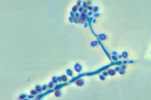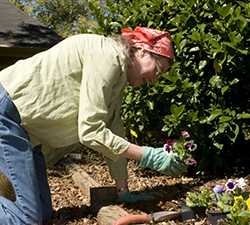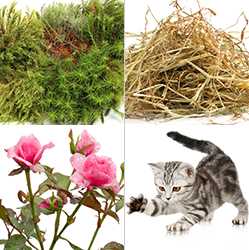Sporotrichosis
Definition

Photomicrograph showing Sporothrix schenckii.
What is sporotrichosis?
Sporotrichosis (also known as “rose gardener’s disease”) is a rare infection caused by a fungus called Sporothrix. This fungus lives throughout the world in soil and on plant matter such as sphagnum moss, rose bushes, and hay.1,2 People get sporotrichosis by coming in contact with the fungal spores in the environment. Cutaneous (skin) infection is the most common form of the infection. It occurs when the fungus enters the skin through a small cut or scrape, usually after handling contaminated plant matter. Some cases of sporotrichosis have been associated with scratches or bites from animals, particularly cats.
Types of sporotrichosis
- Cutaneous (skin) sporotrichosis is the most common form of the infection. It usually occurs on a person’s hand or the arm after they have been handling contaminated plant matter.
- Pulmonary (lung) sporotrichosis is very rare but can happen after someone breathes in fungal spores from the environment.
- Disseminated sporotrichosis occurs when the infection spreads to another part of the body, such as the bones, joints, or the central nervous system. This form of sporotrichosis usually affects people who have weakened immune systems, such as people with HIV infection (see Risk & Prevention).
Symptoms
The symptoms of sporotrichosis depend on where the fungus is growing. Contact your healthcare provider if you have symptoms that you think are related to sporotrichosis.
Sporotrichosis usually affects the skin or tissues underneath the skin. The first symptom of cutaneous (skin) sporotrichosis is usually a small, painless bump that can develop any time from 1 to 12 weeks after exposure to the fungus. The bump can be red, pink, or purple, and it usually appears on the finger, hand, or arm where the fungus has entered through a break in the skin. The bump will eventually grow larger and may look like an open sore or ulcer that is very slow to heal. Additional bumps or sores may appear later near the original one.
Pulmonary (lung) sporotrichosis is less common than the cutaneous (skin) form of the infection. Symptoms include cough, shorthess of breath, chest pain, and fever.
Symptoms of disseminated sporotrichosis depend on the body part affected. For example, infection of the joints can cause joint pain that may be confused with rheumatoid arthritis. Infections of the central nervous system can involve difficulty thinking, headache, and seizures.
Risk & Prevention
Who gets sporotrichosis?
 Overall, sporotrichosis is rare, but people who handle plant matter such as sphagnum moss, rose bushes, or hay are more likely to get the infection. For example, sporotrichosis outbreaks have occurred among forestry workers, people who worked in tree nurseries and garden centers, and people who handled hay bales.
Overall, sporotrichosis is rare, but people who handle plant matter such as sphagnum moss, rose bushes, or hay are more likely to get the infection. For example, sporotrichosis outbreaks have occurred among forestry workers, people who worked in tree nurseries and garden centers, and people who handled hay bales.
The severe forms of sporotrichosis (those that affect the lungs, bones or joints, or central nervous system) usually affect people with weakened immune systems or underlying diseases including diabetes, chronic obstructive pulmonary disease (COPD), alcoholism, or HIV infection.1,3,4
How can I lower the chance of developing sporotrichosis?
You can lower the chance of getting sporotrichosis by wearing protective clothing such as gloves and long sleeves when handling plant matter that can cause minor cuts or scrapes.
Sources

Sporotrichosis is often associated with sphagnum moss, rose bushes, hay, or animal scratches or bites.
The fungus that causes sporotrichosis lives in the environment.
Sporothrix, the fungus that causes sporotrichosis, lives in the environment in soil and on plant matter such as sphagnum moss, rose bushes, hay, or wood. The microscopic fungus can enter the skin through small cuts or scrapes. In rare cases, breathing in the fungus can cause pulmonary (lung) infection. Sporotrichosis is not contagious and can’t spread from person to person. Some cases are caused by scratches or bites from animals, particularly cats (however, this is not the same as cat-scratch disease).
Diagnosis & Testing
How is sporotrichosis diagnosed?
Sporotrichosis is typically diagnosed when your healthcare provider takes a small tissue sample (biopsy) of the infected area of the body. The sample is sent to laboratory for tests (usually a fungal culture) to find out what is causing the infection. Blood tests can help diagnose severe sporotrichosis, but they often can’t diagnose a cutaneous (skin) infection.
Treatment
How is sporotrichosis treated?
Most cases of sporotrichosis only involve the skin or the tissues underneath the skin. These infections are not life-threatening but must be treated with prescription antifungal medication for several months. The most common treatment for this type of sporotrichosis is itraconazole, taken by mouth for 3 to 6 months. Supersaturated potassium iodide (SSKI) is another treatment option for cutaneous (skin) sporotrichosis. However, SSKI and azole drugs like itraconazole should not be used during pregnancy.
Patients with severe forms of sporotrichosis are usually treated with amphotericin B, which is given through a vein. Itraconazole is often used after the initial treatment with amphotericin B, for a total of at least 1 year of antifungal treatment. People with sporotrichosis in the lungs may also need surgery to cut away the infected tissue.
Healthcare providers: for detailed treatment guidelines, please refer to the Infectious Diseases Society of America’s Clinical Practice Guidelines for the Management of Sporotrichosis [PDF - 11 pages].
Statistics
How common is sporotrichosis?
Sporotrichosis is rare, but the number of cases is difficult to determine because there is no national surveillance for it in the United States. Population-based incidence estimates for sporotrichosis were obtained from laboratory surveillance in the San Francisco Bay Area during 1992–1993 and suggested a yearly rate of less than one case per 1 million population.5 Sporotrichosis may be more common in other parts of the world such as Latin America.2 For example, in the state of Rio de Janeiro, Brazil, more than 2,200 cases were reported during 1998–2009.6 Another study suggested a rate of 48 to 60 sporotrichosis cases per 100,000 population in the south central highlands of Peru.7
Sporotrichosis outbreaks
In the United States, sporotrichosis outbreaks have occurred among people who handled sphagnum moss or hay, such as forestry workers,8,9 tree nursery and garden center workers,10-12 and people who worked with or played on hay bales.13-16 Sporotrichosis outbreaks also have been reported in several other countries, including Australia, Brazil, China, Guatemala, and South Africa.2 Healthcare providers who are concerned about an unusual number of new cases should contact their state or local public health agency.
More Resources
MMWR Articles:
- Multistate Outbreak of Sporotrichosis in Seedling Handlers, 1988. MMWR 1988; 37:652-3.
- Sporotrichosis Among Hay-Mulching Workers – Oklahoma, New Mexico. MMWR 1984; 33:682-3.
- Sporotrichosis Associated with Wisconsin Sphagnum Moss. MMWR 1982; 31:542-4.
Related Links
References
- Barros MB, de Almeida Paes R, Schubach AO. Sporothrix schenckii and Sporotrichosis. Clinical microbiology reviews. 2011 Oct;24(4):633-54.
- Chakrabarti A, Bonifaz A, Gutierrez-Galhardo MC, Mochizuki T, Li S. Global epidemiology of sporotrichosis. Med Mycol. 2015 Jan;53(1):3-14.
- Kauffman CA. Sporotrichosis. Clin Infect Dis. 1999 Aug;29(2):231-6.
- Aung AK, Teh BM, McGrath C, Thompson PJ. Pulmonary sporotrichosis: case series and systematic analysis of literature on clinico-radiological patterns and management outcomes. Med Mycol. 2013 Jul;51(5):534-44.
- Rees JR, Pinner RW, Hajjeh RA, Brandt ME, Reingold AL. The epidemiological features of invasive mycotic infections in the San Francisco Bay area, 1992-1993: results of population-based laboratory active surveillance. Clin Infect Dis. 1998 Nov;27(5):1138-47.
- Barros MB, Schubach TP, Coll JO, Gremiao ID, Wanke B, Schubach A. [Sporotrichosis: development and challenges of an epidemic]. Pan American journal of public health. 2010 Jun;27(6):455-60.
- Pappas PG, Tellez I, Deep AE et al. Sporotrichosis in Peru: description of an area of hyperendemicity. Clin Infect Dis 2000; 30: 65–70.
- Powell KE, Taylor A, Phillips BJ, Blakey DL, Campbell GD, Kaufman L, et al. Cutaneous sporotrichosis in forestry workers. Epidemic due to contaminated Sphagnum moss. JAMA. 1978 Jul 21;240(3):232-5.
- Coles FB, Schuchat A, Hibbs JR, Kondracki SF, Salkin IF, Dixon DM, et al. A multistate outbreak of sporotrichosis associated with sphagnum moss. Am J Epidemiol. 1992 Aug 15;136(4):475-87.
- Hajjeh R, McDonnell S, Reef S, Licitra C, Hankins M, Toth B, et al. Outbreak of sporotrichosis among tree nursery workers. J Infect Dis. 1997 Aug;176(2):499-504.
- D’Alessio D, Leavens LJ, Strumpf GB, Smith CD. An Outbreak of Sporotrichosis in Vermont Associated with Sphagnum Moss as the Source of Infection. NEJM. 1965 May 20;272:1054-8.
- CDC. Sporotrichosis associated with Wisconsin sphagnum moss. MMWR. 1982 Oct 15;31(40):542-4.
- Dooley DP, Bostic PS, Beckius ML. Spook house sporotrichosis. A point-source outbreak of sporotrichosis associated with hay bale props in a Halloween haunted-house. Arch Internal Med. 1997 Sep 8;157(16):1885-7.
- CDC. Sporotrichosis among hay-mulching workers--Oklahoma, New Mexico. MMWR. 1984 Dec 7;33(48):682-3.
- Laur WE, Posey RE, Waller JD. A familial epidemic of cutaneous sporotrichosis occurring in north Texas. Cutis. 1979 Feb;23(2):205-8.
- Dahl BA, Silberfarb PM, Sarosi GA, Weeks RJ, Tosh FE. Sporotrichosis in children. Report of an epidemic. JAMA. 1971 Mar 22;215(12):1980-2.
- Page last reviewed: January 30, 2017
- Page last updated: August 18, 2016
- Content source:


 ShareCompartir
ShareCompartir